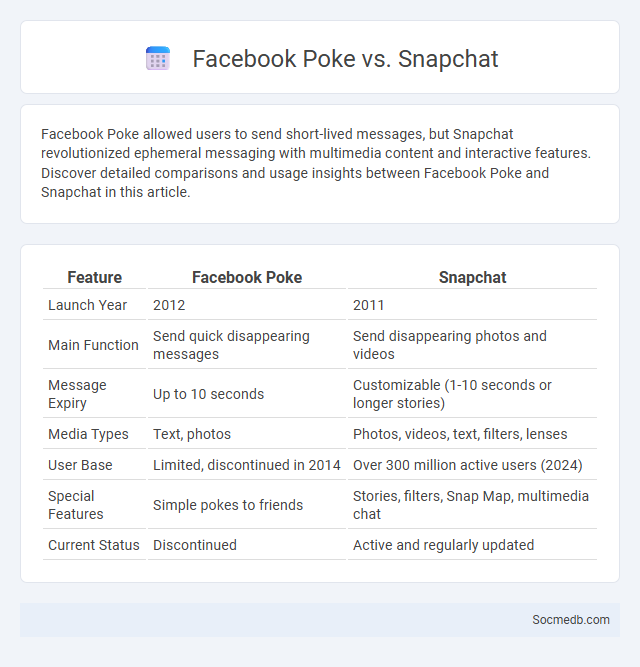
Photo illustration: Facebook Poke vs Snapchat
Facebook Poke allowed users to send short-lived messages, but Snapchat revolutionized ephemeral messaging with multimedia content and interactive features. Discover detailed comparisons and usage insights between Facebook Poke and Snapchat in this article.
Table of Comparison
| Feature | Facebook Poke | Snapchat |
|---|---|---|
| Launch Year | 2012 | 2011 |
| Main Function | Send quick disappearing messages | Send disappearing photos and videos |
| Message Expiry | Up to 10 seconds | Customizable (1-10 seconds or longer stories) |
| Media Types | Text, photos | Photos, videos, text, filters, lenses |
| User Base | Limited, discontinued in 2014 | Over 300 million active users (2024) |
| Special Features | Simple pokes to friends | Stories, filters, Snap Map, multimedia chat |
| Current Status | Discontinued | Active and regularly updated |
Introduction to Social Media Interaction Features
Social media interaction features include likes, comments, shares, and direct messaging, enabling users to engage actively with content and each other. These tools foster community building by facilitating real-time communication and content dissemination across platforms such as Facebook, Instagram, and Twitter. Understanding how your audience interacts with these features can enhance engagement strategies and boost your online presence effectively.
What is Facebook Poke?
Facebook Poke is a feature that allows you to send quick, ephemeral messages or notifications to friends, resembling a virtual tap to get their attention. This tool was designed for casual interactions, enabling brief communication without permanent posts or messages. Your friends receive a simple alert, prompting them to respond or acknowledge the poke, enhancing social engagement on the platform.
Understanding Snapchat’s Unique Approach
Snapchat redefined social media by prioritizing ephemeral content, enabling users to share photos and videos that disappear after viewing, fostering spontaneous and authentic communication. Its innovative use of augmented reality filters and lenses creates immersive experiences that engage younger demographics uniquely compared to traditional platforms. The app's emphasis on privacy through temporary messages and Stories offers a distinct user experience centered on real-time interaction and creativity.
The Rise and Fall of Poke Apps
The rise of poke apps on social media marked a new wave of user interaction, enabling quick, playful notifications that boosted engagement. These apps initially thrived by tapping into users' desire for instant, low-effort communication, but their popularity waned as audiences gravitated toward more integrated and feature-rich platforms. To stay relevant, your social media strategy should consider the evolving preferences that led to poke apps' decline and prioritize tools fostering meaningful connections.
Key Features Comparison: Facebook Poke vs Snapchat
Facebook Poke allows you to send brief messages, photos, or videos that disappear after a set time, focusing on simple, ephemeral communication with limited filters and effects. Snapchat offers more advanced features, such as customizable filters, lenses, Stories, and interactive elements, enhancing user engagement through real-time multimedia sharing. Your choice depends on whether you prefer Facebook Poke's straightforward, fleeting exchanges or Snapchat's dynamic, feature-rich platform.
User Experience: Engagement and Privacy
User experience on social media platforms heavily relies on seamless engagement features such as intuitive navigation, personalized content feeds, and interactive tools like comments and reactions that foster community interaction. Privacy controls play a crucial role by offering users customizable settings to manage data sharing, enhance security through two-factor authentication, and ensure transparency regarding data usage policies. Balancing engagement and privacy improves user trust, retention, and overall platform success.
Popularity Trends and Usage Statistics
Social media platforms like TikTok, Instagram, and Facebook dominate global user engagement, with TikTok experiencing the fastest growth among Gen Z users, reaching over 1 billion active monthly users in 2024. Daily social media usage averages 2.5 hours, highlighting its integral role in communication, entertainment, and marketing strategies. Understanding these popularity trends and usage statistics helps you tailor content to capture and retain your target audience effectively.
Security and Privacy Concerns
Social media platforms face significant security and privacy concerns due to frequent data breaches exposing millions of user accounts and personal information. Users often risk unauthorized access, identity theft, and surveillance because of inadequate encryption and lax privacy policies. Implementing robust security measures, including end-to-end encryption and strict data access controls, is critical to protecting user privacy on these networks.
Impact on Digital Communication Culture
Social media platforms have revolutionized digital communication culture by fostering instant connectivity and real-time information sharing across the globe. Your interactions are shaped by diverse multimedia formats, amplifying personal expression and enabling communities to form around shared interests and causes. This shift has also led to evolving norms in language use, attention spans, and the balance between public and private discourse online.
Future Prospects for Short-Lived Messaging Apps
Short-lived messaging apps are poised to transform digital communication by emphasizing privacy and ephemeral content, catering to users' growing demand for transient interactions. Advances in AI and blockchain technology will enhance these platforms' security features, making temporary chats more secure and appealing for sensitive exchanges. This innovation trend will likely drive widespread adoption across social media, influencing marketing strategies and personal communication norms.
 socmedb.com
socmedb.com